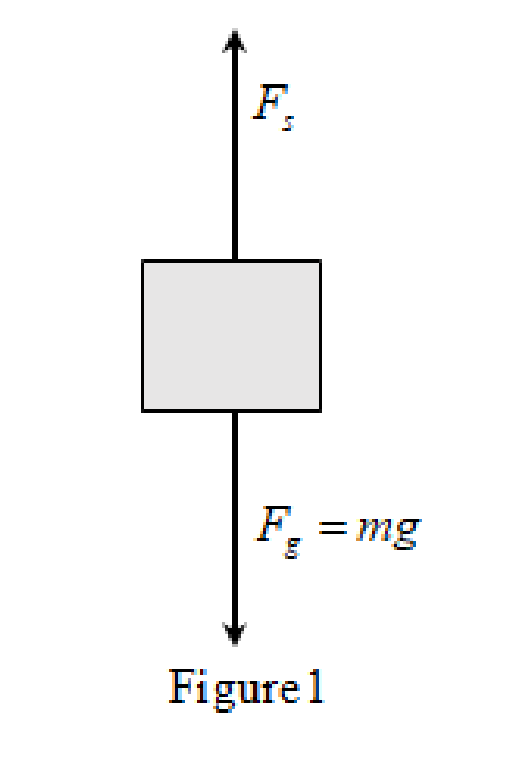
Concept explainers
(a)
The length of the cord.
(a)
Answer to Problem 85CP
The length of the cord is
Explanation of Solution
Consider the body-cord-baloon as a isolated system under gravitation force.
Since the potential energy of the daredavil is transformed to spring energy of the cord.
Write the equation for conservation of energy
Here,
Since there is no initial and final motion and hence the change in kintetic energy is zero.
Subsitute
Write the expression for total potential energy
Here,
Write the expression for potential energy of the cord of length
Write the expression for potential energy due to gravity
Here,
Write the expression for change in total potential energy
Here,
Substitute
Here,
Simplify the above equation.
Since the daredavil finds out the length of stretched cord when hanging at rest by it.

Write the expression for equation for force from Figure 1.
Here,
Write the expression for body weight
Here,
Write the expression for spring force
Here,
Substitute
Since the cord is uniform and elastic.
Hence, spring constant of cord is proportional to the length of the cord.
Rearange the above equation.
When the daredavil test the cord he finds out that his body weight stretches it.
The rate of stretch of the spring or cord is depends on the length and stiffness of the spring or cord. The rate of stretches is the ratio of change in length or stretches to the orginal length of the spring or cord. If the the length of the spring or cord is
Substitute
Simplify the above equation.
Substitute
Since the length of stretched cord should be the equal to the length of the jump.
Write the equation for streched length of the cord which has
Sustitute
Conclusion:
Substitute
Simplify the above expression in terms of
Substitute
Solve the above quadratic equation.
Since the length of the cord cannot be more than
Thus, the length of the cord is
(b)
The maximum acceleration which daredevil will experience.
(b)
Answer to Problem 85CP
The maximum acceleration which daredevil will experience is
Explanation of Solution
Write the equation for motion of daredevil
Here,
Substitute
Solve the above equation to find the expression for
Substitute
Simplify the above equation.
Write the expression for stretched cord length
Rearrange the above equation.
Here,
When the daredevil uses the cord of
Conclusion:
Substitute
Substitute
Thus, the maximum acceleration which daredevil will experience is
Want to see more full solutions like this?
Chapter 8 Solutions
Bundle: Physics for Scientists and Engineers with Modern Physics, Loose-leaf Version, 9th + WebAssign Printed Access Card, Multi-Term
- A man slides two boxes up a slope. The two boxes A and B have a mass of 75 kg and 50 kg, respectively. (a) Draw the free body diagram (FBD) of the two crates. (b) Determine the tension in the cable that the man must exert to cause imminent movement from rest of the two boxes. Static friction coefficient USA = 0.25 HSB = 0.35 Kinetic friction coefficient HkA = 0.20 HkB = 0.25 M₁ = 75 kg MB = 50 kg P 35° Figure 3 B 200arrow_forwardA golf ball is struck with a velocity of 20 m/s at point A as shown below (Figure 4). (a) Determine the distance "d" and the time of flight from A to B; (b) Determine the magnitude and the direction of the speed at which the ball strikes the ground at B. 10° V₁ = 20m/s 35º Figure 4 d Barrow_forwardThe rectangular loop of wire shown in the figure (Figure 1) has a mass of 0.18 g per centimeter of length and is pivoted about side ab on a frictionless axis. The current in the wire is 8.5 A in the direction shown. Find the magnitude of the magnetic field parallel to the y-axis that will cause the loop to swing up until its plane makes an angle of 30.0 ∘ with the yz-plane. Find the direction of the magnetic field parallel to the y-axis that will cause the loop to swing up until its plane makes an angle of 30.0 ∘ with the yz-plane.arrow_forward
- A particle with a charge of − 5.20 nC is moving in a uniform magnetic field of (B→=−( 1.22 T )k^. The magnetic force on the particle is measured to be (F→=−( 3.50×10−7 N )i^+( 7.60×10−7 N )j^. Calculate the y and z component of the velocity of the particle.arrow_forwardneed answer asap please thank youarrow_forward3. a. Determine the potential difference between points A and B. b. Why does point A have a higher potential energy? Q = +1.0 C 3.2 cm 4.8 cm Aarrow_forward
 Classical Dynamics of Particles and SystemsPhysicsISBN:9780534408961Author:Stephen T. Thornton, Jerry B. MarionPublisher:Cengage Learning
Classical Dynamics of Particles and SystemsPhysicsISBN:9780534408961Author:Stephen T. Thornton, Jerry B. MarionPublisher:Cengage Learning Principles of Physics: A Calculus-Based TextPhysicsISBN:9781133104261Author:Raymond A. Serway, John W. JewettPublisher:Cengage Learning
Principles of Physics: A Calculus-Based TextPhysicsISBN:9781133104261Author:Raymond A. Serway, John W. JewettPublisher:Cengage Learning Physics for Scientists and Engineers: Foundations...PhysicsISBN:9781133939146Author:Katz, Debora M.Publisher:Cengage Learning
Physics for Scientists and Engineers: Foundations...PhysicsISBN:9781133939146Author:Katz, Debora M.Publisher:Cengage Learning Physics for Scientists and Engineers, Technology ...PhysicsISBN:9781305116399Author:Raymond A. Serway, John W. JewettPublisher:Cengage Learning
Physics for Scientists and Engineers, Technology ...PhysicsISBN:9781305116399Author:Raymond A. Serway, John W. JewettPublisher:Cengage Learning College PhysicsPhysicsISBN:9781285737027Author:Raymond A. Serway, Chris VuillePublisher:Cengage Learning
College PhysicsPhysicsISBN:9781285737027Author:Raymond A. Serway, Chris VuillePublisher:Cengage Learning University Physics Volume 1PhysicsISBN:9781938168277Author:William Moebs, Samuel J. Ling, Jeff SannyPublisher:OpenStax - Rice University
University Physics Volume 1PhysicsISBN:9781938168277Author:William Moebs, Samuel J. Ling, Jeff SannyPublisher:OpenStax - Rice University





